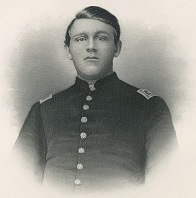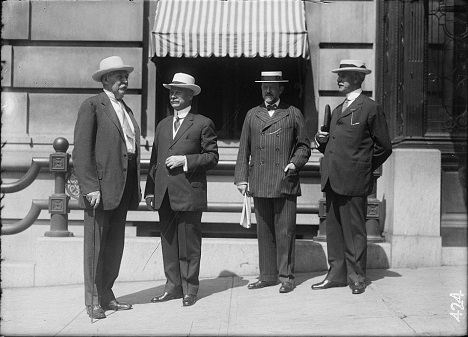
|
Photo of the Month |
|
|
 |
Norman Ream, 85th Pennsylvania Infantry, Civil War |
Norman Bruce Ream, born in 1844 in a small log cabin in Ursina, Somerset County, PA, survived two Civil War wounds and a disastrous fire in his hometown to venture to Chicago, help build some of the nation's mightiest industrial and cultural empires, and then become one of the nation's wealthiest men in New York City, working alongside the most influential men in the country. In this photograph, courtesy of the Library of Congress, he stands with fellow U.S. Steel board directors Richard Lindaburg, Percival Roberts and Elbert H. Gary (for whom the city of Gary, Indiana is named).
After the outbreak of the Civil War, the 18-year-old Norman and his cousin Ross Sanner walked a 29-mile distance to Uniontown, PA to be mustered into the 85th Pennsylvania Infantry. Many of our Minerd-Miner and Younkin cousins served in the same regiment -- John Devan, Simon Firestone, James Frederick Imel, Jerome B. Jennings, Isaac F. Minerd, James Minerd Jr., William Minerd, James Rowan, Leonard H. Rowan, John Irving White, Harrison K. Younkin, Jacob M. Younkin and John X. Younkin.
In action at White Marsh GA, in February 1864, Norman was shot in the right thigh, with the enemy bullet lodging in the pelvic bone. Then at Weir Bottom Church, on June 1864, during the Battle of the Wilderness, he was wounded behind the right knee, the minie ball cutting through the back part of the leg. Cousin Sanner carried him on his shoulders for about a mile before arriving at a safe place. He received an honorable discharge and returned home, only to lose virtually everything in a fire. He decided to relocate to Osceola, Iowa, about 100 miles southwest of Chicago, along with his widowed father Levi Ream and several siblings.
While in Osceola, Norman worked in the grain and agricultural tool business, but a season of poor crops in 1870 forced him to suspend business. He pushed into the city of Chicago, where he began to make a living as a merchant in livestock and grain in partnership, dealing in livestock and then into commodities. Circa 1883, he is known to have sold in one day a half million bushels of wheat in Chicago, and due to the economics of the time, the move led to a price drop of three-quarters of a cent, which in essence allowed him to manipulate the market. He also helped his friend Philip D. Armour, founder of Armour Meats, corner the market in pork in 1883.
He became a friend and trusted confidante to many of the giants of Chicago, including Marshall Field, Cyrus McCormick and Robert T. Lincoln, son of the president. He helped organize the Chicago World's Fair in 1893 and form the Marshall Field Museum of Natural History. When he moved east to to New York City in 1908, he became an associate of John D. Rockefeller and J.P. Morgan, among others. He was a pioneer in the consolidation of the steel industry and brought together a number of steel plants in the west which formed the Federal Steel Company. When Federal was absorbed by United States Steel in 1901, he became a board director of the corporation. In addition, Norman served on the boards of the Baltimore & Ohio Railroad, the Pullman Company, National Biscuit Co. (Nabisco) and the Equitable Life Assurance Society. It's said that during his business heyday, Norman frequently rode the B&O Railroad, often taking a route along Laurel Hill Creek past his hometown of Ursina and so he could view the graveyard where his mother rested. He once ordered the timber to be cut so he could better view the graveyard and once ordered a retaining wall to be built along the creek to keep floodwaters out. More>>>
|
|
U.S. Steel image courtesy Library of Congress |
|
Copyright © 2017 Mark A. Miner |

